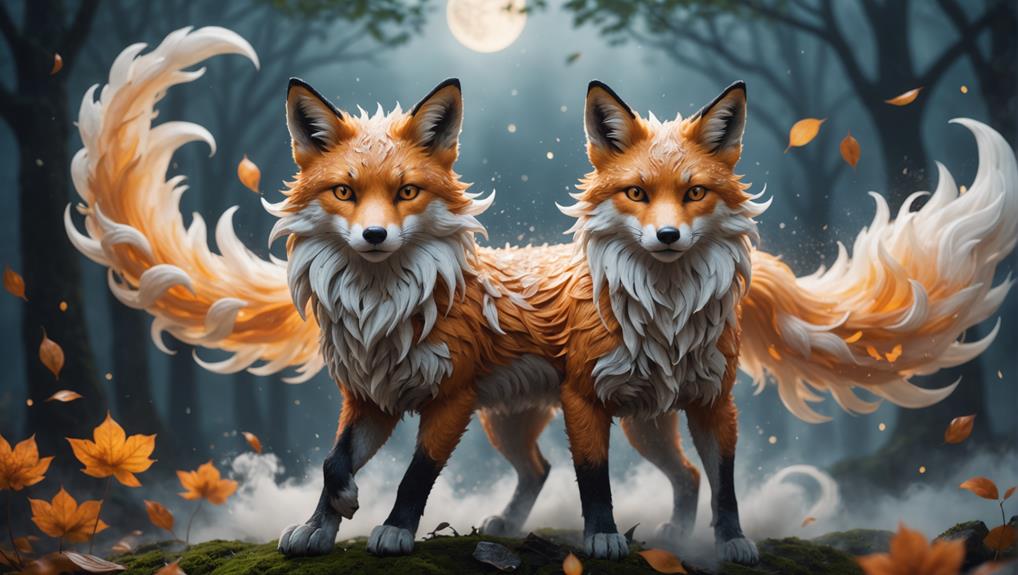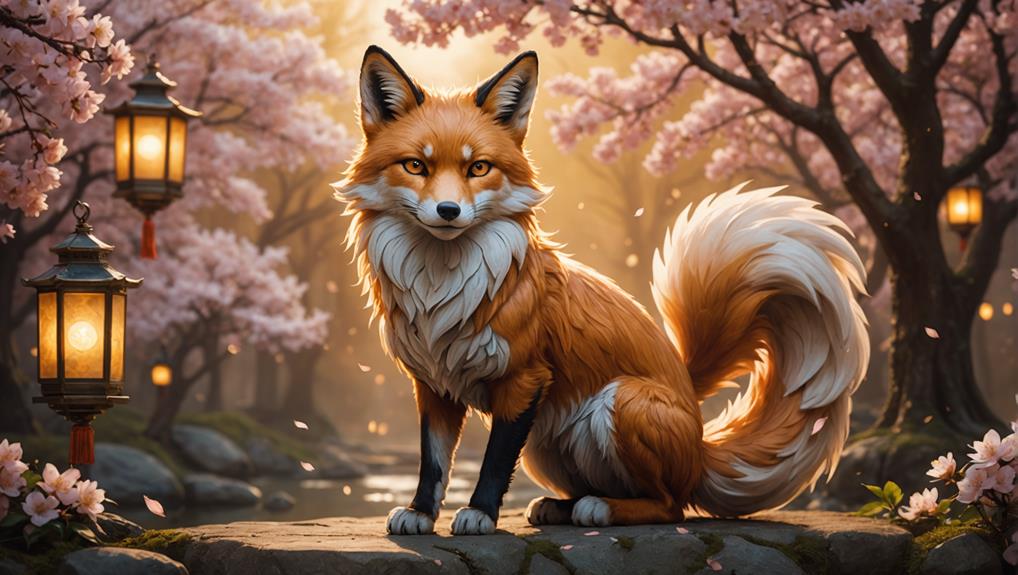In Asian traditions, you'll find that foxes symbolize a lot more than just cunning and intelligence. They represent transformation, dualism, and the complexities of human nature, making them a fascinating creature. From the Chinese Huli Jing to Japanese Kitsune and Korean Kumiho, foxes embody both benevolent and malevolent qualities, often with shape-shifting abilities that add to their mystique. With spiritual significance across cultures, they're revered as protective spirits, associated with femininity and fertility. As you explore the world of fox symbolism, you'll discover how their dual nature reflects the complexities of human society, and how their legend continues to evolve in modern times.
Contents
- 1 Foxes in Folklore and Myth
- 2 Spiritual Significance of Foxes Across Asia
- 3 The Fox as a Transformative Entity
- 4 Foxes in Art and Literature
- 5 Foxes in Modern Cultural Expressions
- 6 Actionable Reflections on Fox Symbolism
- 7 Cultural Symbolism of Foxes Unveiled
- 8 Unpacking the Enigma of Fox Spirits
- 9 Final Thoughts
Foxes in Folklore and Myth
In many Asian cultures, you'll find foxes playing starring roles in folklore and myth. In Chinese folklore, for instance, foxes – particularly the Huli jing – are often depicted as intelligent beings capable of shape-shifting, representing both wisdom and cunning in various narratives.
The nine-tailed fox is a potent symbol in Chinese mythology, associated with auspicious omens and transformation. You might recall the story of Yu the Great, who encountered a nine-tailed fox, heralding positive outcomes.
Fox spirits in Chinese mythology embody a mix of benevolent and malevolent qualities, making them intriguing characters. Their shape-shifting abilities add an extra layer of mystique, as seen in stories where they can take on human forms.
Spiritual Significance of Foxes Across Asia
As you explore the spiritual significance of foxes across Asia, you'll discover that these enigmatic creatures have been imbued with a rich array of symbolic meanings.
From embodying intelligence and cunning in Chinese culture to representing adaptability and cleverness in Native American traditions, the fox's spiritual significance has evolved across cultures, reflecting their unique relationships with humans and the natural world.
Now, let's uncover the fascinating ways in which foxes have been revered as protective spirits, shape-shifters, and symbols of femininity and fertility in various Asian spiritual beliefs.
Fox Spirituality Across Cultures
Beyond the misty mountains and dense forests of Asia, a cunning and enigmatic creature has woven its way into the fabric of spiritual traditions. Foxes are often revered as spirits in Chinese mythology, possessing the ability to adapt and shapeshift. In popular culture, they're depicted as beautiful women, but their significance goes beyond physical allure.
In Japanese mythology, kitsune foxes embody both benevolent and malevolent qualities, reflecting the duality of protection and trickery. Meanwhile, in Korean tradition, the kumiho is a fox spirit that can transform into a seductive woman, symbolizing the danger of temptation.
Tibetan Buddhism, on the other hand, views foxes as symbols of cleverness and adaptability, teaching us how to overcome ignorance and navigate life's challenges. Across these cultures, foxes are celebrated as intermediaries between the human and spiritual realms, serving as totems for guidance and protection.
As you delve into the world of fox spirituality, you'll discover a rich tapestry of symbolism and significance, revealing the complexities of human nature and our place in the universe.
Fox Symbolism Evolution
Across Asia, numerous cultures have woven the fox into their spiritual fabric, imbuing it with symbolic meanings that reflect its remarkable adaptability. As you delve into the world of fox symbolism, you'll discover that this adaptable nature has led to a rich tapestry of meanings across different cultures.
In Chinese culture, the nine-tailed fox is a symbol of transformation and auspicious omens, highlighting its capacity for both benevolence and danger. Meanwhile, in Japanese culture, the kitsune is revered as a supernatural being with shapeshifting abilities, embodying both wisdom and seduction.
In Southeast Asian traditions, fox imagery is often connected to feminine power and fertility, with beliefs surrounding fox spirits linking them to local deities and agricultural abundance.
What's striking is that narratives surrounding foxes across Asia often emphasize their duality, illustrating their role as both harbingers of good fortune and entities of deception. This duality sheds light on the cultural introspection of human traits, making the fox a fascinating symbol in Asian traditions.
The Fox as a Transformative Entity

Many Asian cultures, particularly in China, revere foxes as master shapeshifters, capable of transforming from animal to human form with uncanny ease. You might wonder, what's behind this transformative power? According to legend, a fox can obtain human form through a specific ritual, typically after reaching the age of 50, which signifies a deeper connection to supernatural powers.
The nine-tailed fox, a powerful symbol in folklore, represents increased power and the capability to absorb life essence, ultimately leading to transformation into an even more formidable creature. As a transformative entity, fox spirits, or Huli jing, are often portrayed as seductresses who utilize their transformative abilities to both enchant and deceive, showcasing the duality of their nature as guardians and tricksters.
You'll find that tales involving foxes frequently highlight their interactions with humans, emphasizing that their transformative powers can result in both benevolence and malevolence, depending on the nature of their relationships with mortals.
This complex, multifaceted nature of the fox as a transformative entity has captivated the imagination of many in Asian traditions.
Foxes in Art and Literature
As you explore the world of Asian art and literature, you'll notice that foxes play a starring role, embodying a mix of cleverness, danger, and mystique.
In works like "Journey to the West", fox spirits are depicted as cunning characters, capable of transformation and manipulation, while in traditional Chinese paintings, they're often seen as companions to scholars, symbolizing wisdom and guidance.
Through these representations, you'll discover the complex symbolic meanings and cultural connotations associated with foxes in Asian traditions.
Cultural Representations
In the realm of Chinese art and literature, the enigmatic fox emerges as a dynamic and multifaceted symbol, weaving a rich tapestry of meanings that resonate deeply with the cultural psyche.
You'll often find foxes depicted alongside scholars in Chinese paintings, signifying their role as guides and symbols of auspicious fortune. In ancient stories, fox spirits take center stage, exploring their dual nature as both benevolent guardians and mischievous tricksters, reflecting societal values and moral lessons.
The character of Daji, a notorious fox spirit, exemplifies the seductive yet dangerous portrayal of foxes in literature, showcasing the intersection of beauty, power, and malevolence.
Visual art throughout Chinese history often captures foxes engaged in transformative acts, emphasizing their mythical abilities and significance in traditional cultural narratives.
As you delve into Chinese literature, you'll discover that foxes embody wisdom and intelligence, navigating complex societal situations with ease. Their symbolism is woven into the fabric of cultural narratives, making them a fascinating and complex symbol in Asian traditions.
Symbolic Meanings
Delving into the realm of symbolic meanings, you'll discover that foxes in art and literature embody a multifaceted essence, reflecting their dynamic role in Asian cultural narratives.
In Chinese culture, foxes, particularly the Huli jing, symbolize intelligence and adaptability, often depicted as wise companions to scholars in traditional narratives. Their portrayal in paintings and sculptures serves to celebrate their cleverness, reflecting their dual nature as both benevolent guardians and mischievous tricksters in mythology.
Literary works, such as the tales in Pu Songling's "Strange Stories from a Chinese Studio," explore the complex dynamics of fox spirits, often focusing on gender roles, seduction, and the consequences of human-fox interactions.
Through these stories, you'll see how foxes represent more than just cleverness – they embody the intricacies of human relationships and the blurred lines between good and evil.
Artistic Depictions
Ancient Chinese scrolls unfurl to reveal intricate paintings of foxes, their bushy tails and piercing gazes captivating the viewer. As you delve into the world of Chinese art and literature, you'll notice that foxes are frequent subjects, symbolizing wisdom and guidance.
They're often depicted as companions to scholars, amplifying their auspicious meanings in cultural contexts. In traditional narratives like the "Shanhaijing," fox spirits are described as shape-shifters, able to transform into humans, highlighting their dual nature as benevolent beings and cunning tricksters.
In iconic works like "Journey to the West," fox spirits illustrate themes of allure and betrayal, linking them with the complexities of femininity and morality in folklore.
Artistic representations of foxes often emphasize their cleverness and adaptability, indicating their significance as dynamic subjects reflective of cultural values.
Scholarly analyses, such as Rania Huntington's, explore how these representations reflect deeper societal narratives and gender dynamics. As you explore the artistic depictions of foxes, you'll uncover the intricate web of symbolism and meaning that underlies Chinese culture.
Foxes in Modern Cultural Expressions

Modern storytelling has breathed new life into the fox's cultural significance, reimagining its persona for contemporary audiences. You've probably noticed how foxes are often portrayed as playful and endearing characters in modern media, like in Roald Dahl's "Fantastic Mr. Fox". This popular tale has contributed to a friendly image of the fox that resonates with people of all ages.
In Japanese anime, such as "Kemono Friends", foxes are showcased as cute and charming creatures, further influencing public perceptions of foxes in contemporary culture. The playful and whimsical associations of foxes in modern narratives appeal to audiences universally, reinforcing their cultural relevance.
Recent portrayals blend traditional fox symbolism of cunning and intelligence with innovative narratives that resonate with current societal changes. The continued fascination with foxes in contemporary literature, art, and media underscores their enduring significance and adaptability within popular culture, making them a beloved and timeless symbol.
Actionable Reflections on Fox Symbolism
As you reflect on the fox's modern cultural significance, you may wonder how its symbolism can be applied to your own life. By embracing the wisdom, intelligence, and adaptability embodied by fox spirits, you can cultivate a more compassionate and empathetic approach to serving others.
The nine-tailed fox, with its auspicious connotations, can inspire you to strive for success while remaining humble and grounded.
The complexities of the female fox, both seductress and protectress, remind us to appreciate the multifaceted nature of femininity and the importance of balancing strength and vulnerability.
By acknowledging the supernatural abilities associated with foxes, such as shapeshifting and seduction, you can tap into your own creative potential and develop a more flexible, open-minded approach to problem-solving.
As you integrate these symbolic reflections into your daily life, you'll become a more effective, well-rounded servant to others, embodying the protective and foresightful qualities that Asian traditions have long revered in foxes.
Cultural Symbolism of Foxes Unveiled

Frequently, cultural symbolism surrounding foxes is steeped in intriguing contradictions, reflecting the complexities of human societies.
As you delve into the world of Asian traditions, you'll discover that foxes, particularly the nine-tailed fox, symbolize intelligence and cunning, often representing auspicious omens and societal transformation in Chinese culture.
In Late Imperial China, fox spirits, known as Huli jing, were depicted as both benevolent guardians and cunning seductresses, showcasing a duality of character that reflects societal attitudes towards women.
Across various Asian cultures, foxes serve as symbols of adaptability and cleverness, often woven into folklore and art, showcasing their enduring influence on societal beliefs.
You'll find that foxes are also associated with fertility and femininity, as seen in Celtic mythology, where fox symbols are linked to the goddess Eriu, emphasizing nurturing qualities.
As you explore the cultural symbolism of foxes, you'll uncover a rich tapestry of meanings, each thread reflecting the complexities of human societies and their relationships with nature.
Unpacking the Enigma of Fox Spirits
In the realm of Asian mythology, enigmatic fox spirits have captivated human imagination, embodying a multitude of contradictions that continue to intrigue and mystify.
You're likely familiar with the Huli jing, mystical fox spirits in Chinese culture that can shapeshift and possess both benevolent and malevolent traits, reflecting the duality of their nature. These fox spirits can transform into beautiful women, often seducing men and draining their vitality, symbolizing the intertwining of allure and danger in feminine representations.
In mythology, foxes are associated with wisdom, cunning, and deception, engaging in interactions that blur the lines between human and supernatural realms.
Historical texts, like the Shanhaijing, document early narratives of fox spirits as auspicious yet dangerous beings, highlighting their longstanding significance in folklore.
As you delve deeper into the enigma of fox spirits, you'll discover a cultural reverence that persisted despite suppression attempts, with worship tracing back to the Tang Dynasty.
Final Thoughts
As you've delved into the mystifying realm of fox symbolism in Asian traditions, you've uncovered a world of contradictions – cunning yet benevolent, trickster yet wise. But the enigma remains: what secrets do these shape-shifters still conceal? Will you continue to chase the fox's tail, or will you let its mystical aura whisper secrets in your ear? The pursuit of truth has only just begun, and the fox's silence is deafening.














